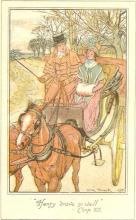inspiration + perspiration = invention :: T. Edison ::
In my part of the eastern United States, the past weekend saw our clocks "spring forward" an hour for Daylight Savings Time. November's chill has blown in, and the stores are already playing Christmas music. Plus, the children's theatre I serve as a board member for is having their first production since the outbreak of the pandemic this Friday, which means time is truly of the essence for us.
Dates and times are also important for Austen's stories, and the characters of Northanger Abbey are no exception. When I first considered writing fan fiction based on this novel I had to consider the calendar quite a lot. Just when, exactly, did Henry and Catherine meet? How old would they be a year later? How would the timing of a sequel impact events?
Fortunately, more people than I have considered these questions. I'm particularly indebted to a wonderful calendar found at Ellen Moody's website that not only listed dates and even times as recounted or inferred by Northanger Abbey, but also a good discussion of how Austen used the description of time for mood or character. Helpful as that chronicle was, I needed to play with the format a little to help me manage it better for the stories I was developing, aided by the discovery of this collection of almanacs online thanks to Google Books.
One of my goals in sharing information about my process has been to encourage other fandom authors to consider this book for their next project. In that spirit, here's a spreadsheet I've used for several stories in the works, with full credit back to Ellen Moody for doing the more difficult research first. You can also download it for playing around with formatting, or adding events for your own story.
For those interested, I gave Catherine a May birthday, and Henry an August one, making them 19 and 27 at the start of Gentlemen of Gloucestershire (a little older than the "perfect happiness at the respective ages of twenty-six and eighteen" found at the end of its predecessor and inspiration). We know they married "within a twelvemonth from the first day of their meeting," which according to this calendar was February 2; I picture them wed during January, possibly just after Twelfth Night or Old Christmas and Epiphany. Feel free to use or ignore these "fanon" details in any work you care to write.
Dates are important for both character and plotting purposes, both for Austen herself and those of us writing today. I myself eventually developed a less detailed calendar for my sequel to keep straight what day of the week things were happening. But more than just keeping track of the passage of days, time itself may play a crucial role in a story.
 Note how Brock drew the trees in this illustration: few or no leaves, fitting for the season.
Note how Brock drew the trees in this illustration: few or no leaves, fitting for the season.
In Northanger Abbey, for example, Henry's professional responsibilities on Sunday allows Austen to seamlessly weave him in and out of the narrative once they arrive at the titular manor home, parting the burgeoning couple at intriguing points but with the reasonable confidence of their coming back together. Church also provides the characters with a meeting place while in Bath, such as when Catherine arranges once again to take her walk with the Tilneys, and is obstructed by Thorpe's interference. The thawing of winter into spring appears to match the blooming of Catherine's relationship with Henry. Personally, I also find it very apropos that using this calendar, Henry's confrontation with his father occurs on St. George's day; whether or not Austen meant the comparison of slaying a dragon, it's certainly an appropriate one.
For my sequel, timing also played a role in determining certain key elements of the story. Whereas Austen's book took place in the earlier parts of the year, I intentionally set mine later, in September, when the season is once again changing back to winder (mirroring their return to Northanger Abbey and its icy master). Originally I did not have a firm handle on some of the Tileny family's motivations. But some further research hit on an excellent excuse to get Captain and General Tilney working on a joint project together, which I owe largely to the influence of the excellent book Jane Austen’s England. This resource not only provides an easily understandable primer on all things Georgian England but also a wealth of references to primary resources for further study.
My September setting fit very neatly in the schedule leading up to Michaelmas on the 29 of that month. On this day rents were collected as the harvest ended, and magistrates had to finalize any business from the previous quarter with the new one beginning. While a parish laymen was usually given the title "Surveyor of the Highways" and could in theory command a certain amount of labor and materials for the task, it was up to the local magistrate (often an influential or affluent person of the local landed gentry) was supposed to supervisor and hold this person accountable. In practice, this work was often ignored by both. But I take General Tilney to be a very energetic person, throwing himself full tilt into tasks he finds worthy of his attention, so roadwork improvements proved a perfect background activity for the gentlemen to become embroiled in.
There is actually another example of timing that influences the early chapters of this novel, although revealing exactly more details now would reveal a slight spoiler. Suffice to say it is not something happening in England, but elsewhere in the world, that will be made clear in future chapters. Readers who are eager to theorize on this mystery might remember that Captain Tilney is (or was, until his injury) still an active member of the armed forces.
Finally, time has played a key role in how I release the chapters of this book. I knew from the start I wanted to prioritize releases on my blog first, twice a week, and worked out a posting calendar based on that schedule to determine when I would begin. But I didn't want readers on other sites to get too far behind, hence the double Mondays. That decision has led to a bit of a time loop for my readership: if you're reading along here, you are now at a point in the story where it is Monday September 16, 1799. However, everyone else is still on the Sunday the day before, and won't move forward a day until later this evening (and given the late night I have for my theatre's rehearsal, it may be much later for them to finally move ahead!)
I'm still evaluating how this dual schedule is working, both for myself and the readers. Again, though I must thank everyone who has commented and responded, on whichever site you've chosen: I appreciate the time anyone devotes to what is largely a personal exercise in creativity.





